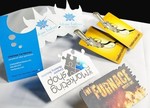

Use our online designer studio to create your own personalised flyers, business cards, greeting cards and more.
Order NowWhen it comes to professional printing and advice on your business marketing, we are the team to call! You can call us direct on 04 568 8773 or fill in our quote form.
Request a Quote
Have you ever gotten a greeting card that has its edge cut around the shape of the artwork, watched a kid peel off those shaped stickers to stick everywhere, seen a fridge magnet in the shape of a van, or even had a simple business card with rounded corners, these are all examples of die-cutting. Now, doing this type work isn’t just the domain of big business, a small business can make use of it too, you just have to be aware of a few factors before you jump with both feet
How do they do it?
If you have ever used a cookie cutter to make a gingerbread man then you’ve seen how it works. Cutting dies are a set of sharp metal blades bent and welded together to cut through a sheet of paper or card leaving behind the cut shape. It’s that simple, the only difference is scale. Where you would cut the gingerbread men one at a time, cutting dies as many of the items it can fit into a printing sheet. The cutting die can have strips that make perforations, sections to punch holes, or make embossing or creases too. See the example image of how it works.
seen how it works. Cutting dies are a set of sharp metal blades bent and welded together to cut through a sheet of paper or card leaving behind the cut shape. It’s that simple, the only difference is scale. Where you would cut the gingerbread men one at a time, cutting dies as many of the items it can fit into a printing sheet. The cutting die can have strips that make perforations, sections to punch holes, or make embossing or creases too. See the example image of how it works.
What sort of shapes can you make?
While there’s no theoretical limit on the shapes you could make. It depends on many factors. Most printing companies will have a set of standard shapes, but die cuts and vinyl cutters can be made for almost any shape (within reason).
So what do I have to pay to have something die cut?
It depends on what you are doing. If you are using what the finishing company has as part of their standard libraries of shapes, the business card with rounded corners being a example, then you are only paying the extra labour involved in using a cutting die. If you want a non standard shape, you will be paying for the design and manufacturing of the die to be used. This usually will set you back hundreds of dollars on top of the labour of doing the cutting work. You will then own the die so you only have to pay for the cutting for each subsequent run. However, every finishing company I’ve looked at also include a clause that states that, if you don’t use your die at least once every 12 months, they will recycle it to free up space and then you have to go through the process and cost of having a new one made.
Are there other options?
We are seeing the rise of lightweight CNC machines ( C omputer N umeric C ontrol), but instead of using a set of blades in a fixed shape pressed into stacks of paper, they use a computer controlled arm to move a cutting head around each sheet individually. This does give them a lower setup overhead as there is no die that has to be made or stored but they do operate at a slower speed and they are unable to add things like embossing or creasing. Currently, I have not seen in them in use for small run work, but they will come in eventually.
Is die-cutting an option for the small business?
That is the big question. It really all depends on the quantity of labels you are printing. A die can cost several hundred dollars (and up), but if you are printing tens of thousands then it is only adding pennies to the per-unit cost. If you can’t justify that, then are other solutions to it. In one such case, a customer wanted a jigsaw puzzle piece cut out of one corner of the flyer but the cost wasn’t justified so we did a redesign where the bit that was to be cut out was printed in a contrasting colour to give the same effect while keeping the cost reasonable. This is where talking to us at Copy Express will help as we will work with you to find the most cost effective solution to your needs.